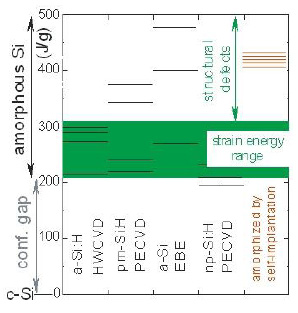The energy of amorphous silicon - an essential material for the new generation of photovoltaic panels and for flat panel displays - is 50% lower than the value so far assigned to it. This is the main conclusion of a study carried out by researchers of the University of Girona, Catalonia, Spain, in collaboration with laboratories at the University of Barcelona and at the French CNRS that has been published in Physica Status Solidi (RRL) - Rapid Research Letters.
According to the opinion of an expert in amorphous materials, this information is relevant for the comprehension of the structure of amorphous silicon and for improving its properties.

In contrast with crystalline materials, where the atoms are spatially ordered, amorphous materials do not have a well-defined energy. This is because the ordered state is unique, whereas the atoms in an amorphous structure can be disordered according to a large set of configurations with different energies. By the end of the 1980s, theory predicted that amorphous silicon could only exist above a minimum degree of disorder. This least disordered configuration, known as "the relaxed state", leads to maximum material stability. For this reason, thin film deposition techniques attempt to get films as close as possible to this state.
In spite of the importance of the theoretical prediction, to date its energy had not been correctly determined. During the research just published in pss (RRL) the energy of about 20 samples grown by several deposition techniques was measured by differential scanning calorimetry. The authors highlight that, although different values were obtained for samples deposited in the same way, the minimum value coincided for all deposition techniques. This has led to the conclusion that this minimum energy is, in fact, that of the relaxed state. Its value is 50% lower than the one taken as reference so far. It represents a key parameter for specialists studying the structure of amorphous silicon, because the theoretical models describing the material will be considered more or less realistic depending on their ability to approach this value.
Finally, the new results help us understand the findings gained through years of practice with amorphous silicon deposition: the best films are those deposited from the vapour phase and those which have hydrogen atoms in their structure.